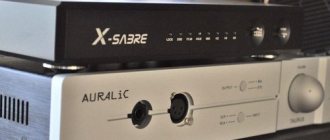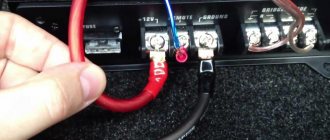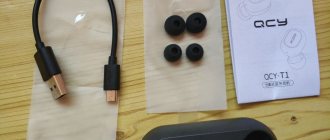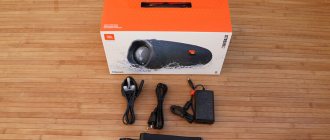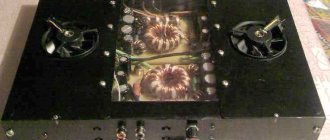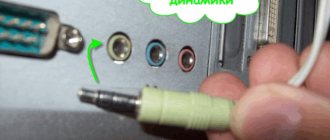DAC Saber ES9038PRO crystek cchd-575 + muse03 * 2 + muse02 * 2 + Amanero
For quite a long time I used a DAC purchased from the Chinese store Inntak on Saber ES9018 + 2x Muses8920 + 2xAD797 + 2 R-Core. It had XMOS installed as a USB receiver, which I did not use, since in my system the digital source is quite far from the amplifier and DAC and therefore I transmit the digital via coaxial. The Chinese love XMOS more due to the fact that it is problem-free in terms of transmitting a DSD stream; with Amanero there are some issues in this matter. As for the sound of transports, it is obvious to me that Amaero has a better sound, more lively. The Inntak DAC was magnificent, super airy, detailed, with such spatiality that it always seemed like someone had turned on an echo effect to better convey the volume of the room.
Now my DAC has been replaced by a new contender - in principle, it’s still the same old friend, but with more expensive components.
Firstly, the chip itself is the latest generation Saber ES9038PRO - it’s the same as the ES9018 - the flagship of the line.
Of course, the configuration of the DAC itself (not the chip) has undergone global changes, so it’s difficult for me to isolate which element affects the sound, but the general impression is that the 9038 and 9018 are not the same. The differences in this are seen in the algorithms built into the chip. If previously they were tightly hardwired into the chip and you could only switch them, trying to understand what had changed (imperceptible by ear), then in the 9038 the filters can be reprogrammed, and the 8 filters included in the kit have a difference (not all of them, of course).
Further, the DAC under review has higher-quality audio and more expensive operational amplifiers - a pair of Muses02 and a pair of Muses03.
I was informed that such a combination would be far from optimal in technical terms, so I was a little worried about the sound, but it turned out to be in vain.
Muses02 is a two-channel bipolar operational amplifier. Slew rate 5 v.
It is the best for audio preamplifiers, active filters, and line amplifiers with excellent sound.
Muses03 is a J-FET (read mosfet) single operational amplifier with a slew rate of 35 volts. Distortion 0.00003% (3 ppm).
The MUSES03 is a high-quality sound J-FET input single operational amplifier for premium audio equipment.
Both are created for Hi-End audio, which is indicated in the datasheet to one degree or another.
Next, as an upgrade, instead of the gold TXCOs, the more expensive Crystek cchd-575 was installed.
They offered to supply me with an even more expensive piece by adding 35 dollars, but I refused.
Next in the configuration are two R-Core transformers, which I favor in DACs more than tori.
When I received the DAC, I shook it as usual and felt some movement inside, as expected after long transportation. Transformers were moving. I tightened the bolts that were not tightened sufficiently (at the same time I found one unattended one inside the housing), but this did not affect the slightly free swaying of the transformers. Then I noticed the metal ears stretched out in different directions - they were the ones that held the transformers - see the photo, respectively, they cannot be secured more rigidly with this type of fastener.
It immediately draws attention to the fact that the transformers are shielded themselves (copper shell) and shielded from the main board by a metal partition.
Transport I asked to install a Chinese-made Amanero for financial reasons - I already had a Chinese Amanero and I was more than satisfied with its capabilities. I was repeatedly informed that the original Italian Amanero (this is a transport) is better, spatially more voluminous.
The DAC is an upgraded version from a Chinese store, this time MSHOW.
FIRST TURN ON
I connected the Saber ES9038PRO crystek cchd-575 + muse03 * 2 + muse02 * 2 + Amanero DAC via coax as standard to a Yamaha P2200 power amplifier and Diatone DS-2000 speaker systems. This pairing should show potential without any problems.
My main concern is the fear of getting a sound worse than my previous Inntak DAC, which was wildly three-dimensional and airy.
Having turned on Saber ES9038PRO crystek cchd-575 + muse03 * 2 + muse02 * 2 from MShow Store in the first minutes, I heard that the sound was high-quality, but was slightly disappointed, since I did not see a strong difference with the regular version on Muses8920. This lasted until the acoustic guitar started playing in the composition, where I was amazed by the richness of the sound. It was so musical with high detail and microdynamics, and at the same time everything created another layer (not microdynamic) that influenced the cohesion of the sound - fantastically beautiful.
But I was able to get even more from the DAC by remembering that in terms of filters, the Saber9038pro is no longer at all the same as the Saber ES9018.
When I started switching filtering modes and reached the Slow-SL option, I was speechless, the acoustic guitar sounded so beautiful, natural sounds arose (some hits on cymbals, strings), that a presence effect arose that I had only observed on tube or hybrid amplifiers in some specific places in the phonogram. But tube solutions are too much of a compromise in terms of sound accuracy, but here life lived and at the same time showed music in super detail and at the same time super unified, as if contradicting itself.
Since you are reading the first preliminary review, we will keep an eye on it and find new nuances of sound. As for the differences between the previous DAC from Inntak and this one from MShow, the DACs are different, each with its own special twist - it’s hard to say the reason for this is in the op-amp or the 9038/9018 chips themselves. I can only say that the DAC on the Muses02+03 has an even higher sound class without a doubt.
In the Inntak DAC, it seems to me, there is a greater sense of three-dimensionality, localization, and room.
In the MShow DAC, the emphasis is on the fantastic coherence of sound with wildly high detail, as a result the sound texture becomes clearly richer and more interesting - it’s no longer just a 3D space, but an amazing audio performance that you follow with your mouth open.
As a result, I was delighted with listening to the DAC; the more interesting is the existence on the market of this DAC model, allegedly with even higher-class Hi-END discrete solutions instead of an op-amp.
I suggest you watch a video with a Saber ES9038PRO crystek cchd-575 + muse03 * 2 + muse02 * 2 DAC from MShow - the sound was recorded on a Zoom H1 stereo recorder in wav 48 kHz/24 format, then combined into a video in ogv format in the Openshot video editor program, where is the sound 48 kHz (I don’t know how many bits, I hope it’s also 24) in flac format. After which it was uploaded to YouTube, and what he did with the sound, what format he compressed into, one can only guess.
Saber ES9038PRO MShow sounds:
The recording uses two compositions by different artists from one CD (!) on which the video demonstrates the difference in sound quality. One composition is more balanced, another is brighter - all this is the result of mastering at the stage of recording the musicians by a sound engineer.
And then it won’t hurt to remember how the DAC from Inntak sounded, albeit with the more transparent acoustics of the Yamaha NS-1000.
Let's look at Inntak on Saber ES9018:
Both DACs are certainly luxurious, but the Muses 02+03 + filter is a different level of perception, albeit less voluminous, with a strong bias towards naturalness.
iCAN
Specifications
- Amplifier part: completely discrete, class A
- Buffer part: TPA6120A2
- Equalizer: two-level 3D Holographic Sound and XBass controllers
- Signal to noise ratio: > 117 dB
- Total harmonic distortion:
- Frequency range: 0.5 Hz – 500 kHz
- Output Power: >400mW @ 32Ω
- Output voltage: >5 V @ > 600 Ω
- Power consumption:
- Power supply: 100 – 240 V, 50/60 Hz
- Dimensions: 158mm x 68mm x 28mm
- Weight: 216 g
- Input: RCA and 3.5mm
- Output: 6.3mm
Design and delivery package The packaging and appearance of iCAN are almost the same as in iDAC (and iUSB), only the set of connectors and indicators differs. In the case of iCAN, the front panel houses a volume control, two three-position equalizer effect switches and a headphone output. On the rear panel there are both input jacks and a power supply connector, which is external for this amplifier. The upper indicators show the power connection, music playback and the operation of proprietary Direct Drive technology.
In addition to the amplifier itself, in the kit you will receive a power supply, a simple interconnect cable with RCA connectors, a short white cord with two 3.5 mm jacks, 4 silicone feet, an adapter from 6.3 to 3.5 mm and instructions/warranty card .
Sound
- MacBook Pro Early 2011
- DACs: iDAC, Audinst HUD-MX2, Yulong Saber DA8
- Fidelia as a player
- Recordings in lossless formats
- Ambient Acoustics AM6 HiRez, Sennheiser HD650, AKG K702, Fischer Audio FA-003Ti, Philips Fidelio X1
Of course, the main thing that sets iCAN apart from its competitors is the presence of two sound “improvers”. Severe audiophiles usually disdain such additions, but if you don’t let the audiophilia virus infect your brain, you can note that sometimes these features are quite useful. With XBass everything is more or less clear; it is a two-level bass boost. The weaker one enhances the region up to 200 Hz, reaching a maximum of +7 dB at 20 Hz, the strong one works in the region up to 800 Hz, adding +9 dB at 20 Hz.
3D HolographicSound is a beast less commonly found in amplifiers. Its first level is similar to a regular crossfeed: the channels are “mixed” into each other, creating the effect of listening to a large speaker system (I wrote about this in detail in the description of the Fidelia player). The second level is much more interesting and gives an effect that is truly similar to three-dimensional sound, as, for example, SRS does. The most amazing thing is that iCAN achieved this effect without using digital signal processing, using purely analog methods.
These settings are interesting; their different combinations give funny effects and sometimes allow you to hear familiar headphones in a new way. After playing with them, I had to turn them off in order to write objectively about the iCAN sound. In tests, I listened to it with an iDAC and with a Yulong DA8.
The amplification part consists of an amplifier built on discrete components, as well as a buffer amplifier on the TPA6120 chip, which is quite popular in audio technology. The disadvantages of this microcircuit include the need to use a resistor with a resistance of at least 10 Ω in the output circuit, which does not benefit the operation of the amplifier with low-impedance headphones (especially multi-driver headphones), but iFi engineers managed to circumvent this limitation. As I understand it, they used inductance and a low resistance resistor, providing both low output impedance and stability of the chip.
iCAN's sound is neutral, optimized for maximum transparency and inconspicuousness. Very low noise levels provide that “black background” that is so necessary for immersion in detailed and complex music.
The power reserve is enough to unleash the potential of most headphones (maybe with the exception of the tightest ones). Of course, iCAN perfectly complements iDAC if you use complex headphones; it adds everything that the built-in iDAC amplifier lacks: volume, instrument separation, clear and detailed low frequencies. For me, iCAN coped brilliantly with the AKG K702 and the Sennheiser HD600. On the modded Fostex T50RP, I lacked midrange resolution a little, but Fostex are generally very capricious, and are best revealed with amplifiers that provide a very large output current swing. Due to the general neutrality of the amplifier, it is good with almost any headphones: with monitor headphones it will convey all the nuances, and with taste it will not interfere with revealing its own style of presentation.
The only drawback, or rather a feature of iCAN, can be called its high gain: with sensitive headphones, even with a control at 8-9 o’clock, the volume is very high, at least the smooth operation of the control eliminates the problem of setting a comfortable level.
If you want to achieve maximum quality from your desktop computer audio system, you will need a power filter.
conclusions
What do we have in the end? A set of several very good devices, both in terms of design and sound, aimed primarily at “computer audiophiles”, although, of course, the level of the devices will allow them to take a place in more high-end systems. What’s also gratifying is that the manufacturer is actively refining the line, improving existing devices and adding new ones, and the modular design allows you to assemble exactly the “setup” that you need. By the way, iFi's recent innovation, the iTube audio enhancer, is another interesting component that could fit into this ecosystem.
iUSB Power
Specifications
- Two USB ports: one for power only, one for power and data (recommended for use with iFi Gemini cable)
- Output voltage: 5V ± 0.5%
- Output current: 1A
- Output noise: 0.0000001V
- Hi-Speed USB 2.0: 480 MB/s
- Input Voltage: 100V - 240V, 50/60Hz (Ultra Low Noise Power Supply Included)
- Power consumption:
- Dimensions: 158mm x 68mm x 28mm
- Weight: 195 g
Design and delivery Yes, yes, yes, the box and appearance of the device are exactly what we expect. There are two USB outputs on the front panel, one transmits both power and data, the second transmits only power. On the rear panel there is a power connector, a USB input and an IsoEarth function switch. The latter allows you to disconnect from the ground line in the USB power supply and thus significantly reduce the level of interference, however, in some cases this may be incompatible with your computer, so the function is disabled.
The indicators on the top panel are responsible for indicating the presence of power, connection to a PC and the operation of the IsoEarth function.
The package includes a USB cable (as good as the iDAC), power supply, traditional warranty instructions, silicone feet and a white cable with USB on one end and a circular connector on the other. According to company representatives, this cable is designed to power the Logitech Squeeze Box Touch (a device popular among Western audiophiles, who often modd its power supply). Although I've seen reviews that this cable is great for powering iCAN from iUSB Power, saving one outlet space, I haven't tested this option because it's not recommended by the manufacturer.
Sound
- MacBook Pro Early 2011
- DACs: iDAC, Audinst HUD-MX2, Fiio E17
- Fidelia as a player
- Recordings in lossless formats
- Ambient Acoustics AM6 HiRez, Sennheiser HD650, AKG K702, Fischer Audio FA-003Ti, Philips Fidelio X1
It’s worth saying that I was initially skeptical about the idea of devices like iUSB, believing that since USB is a digital bus, then the digital signal is definitely transmitted correctly through it. But it is worth considering the fact that USB, in addition to transmitting data, often also serves as a power source for devices, and this is where all the problems begin in the form of interference from the PC power supply, bad ground, and so on. I encountered this for the first time on a friend’s laptop: he complained that the Fiio E17 DAC played well from one USB port, but when connected to the second it was noisy. The cause of the noise was precisely the interference with the power supply. Of course, poor-quality power supply does not always manifest itself so noticeably; often its “harm” is less noticeable and results in general sound degradation, this will be especially noticeable on DACs whose developers did not take care of filtering the input voltage (it’s funny that in iDAC the filtering is quite good, and the benefits of iUSB are not so noticeable - iFi did not follow the marketing lead and did not specifically make a problem in order to offer a solution).
For iUSB, they developed a special dual Gemini cable that transmits power and data through separate wires. I didn’t have it in the test, I won’t judge its usefulness, but even without it, iUSB is useful.
What does this device do? It replaces USB power from the computer with its own, received from the power supply and additionally filtered by iFi iUSB Power itself. By the way, despite the fact that iFi devices use switching power supplies (which is bad, I wrote in this review), the company has done the maximum to filter out high-frequency interference, so their power supplies are a separate value that can be useful for other gadgets.
The most difficult question is the usefulness of iUSB Power for users. First of all, it depends on how well the power supply for your computer is implemented. If its USB power is already stable, you won't notice such a big increase (although when I listened purely to the iDAC, connecting via iUSB Power improved bass control, partially reducing the complaints about it), but if you are using, for example, a budget laptop - the effect of iUSB Power will be more noticeable. Secondly, it depends on your perfectionism. If you're willing to pay for a small step closer to perfection, then the iUSB Power is a good addition to your system, especially when using USB-powered DACs.
